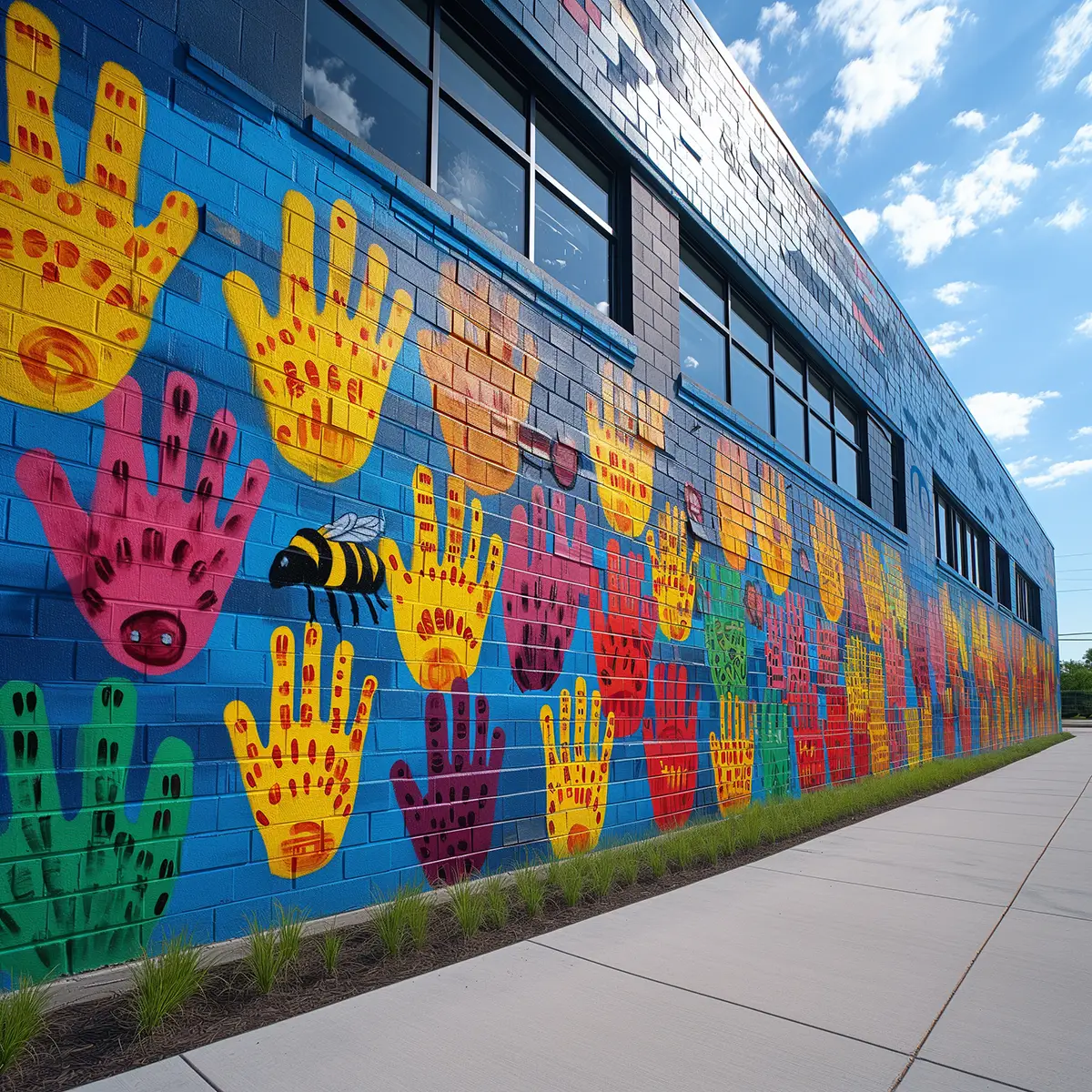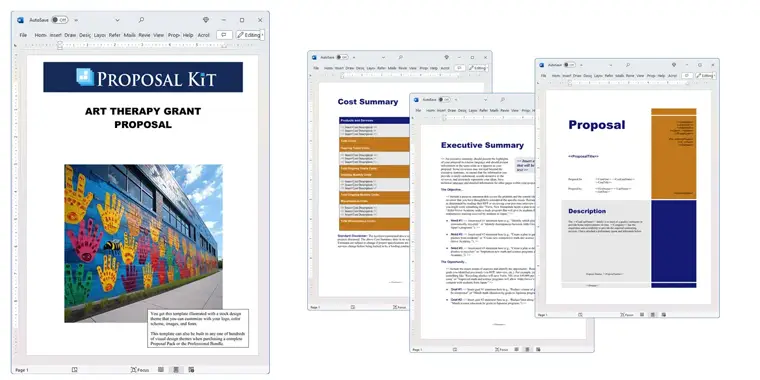How to write your Art Therapy Grant Proposal
We include this 20 page layout with every Proposal Pack. If you want this template to have a different visual design theme than the one illustrated here, purchase any Proposal Pack design and create this template using the purchased design theme. This template is included in every Proposal Pack. If you get a Proposal Pack or the Professional, you can also make any variation of this template with different chapters to suit your needs.
We typically include more chapters in the templates than most people will need to give everyone more variety in the chapters they may need. You can trim down a long template by removing pages you do not need or combining multiple chapter topics into one page.
 DOWNLOADABLE, ONE-TIME COST, NO SUBSCRIPTION FEES
DOWNLOADABLE, ONE-TIME COST, NO SUBSCRIPTION FEESYou can also create countless variations of this document to suit your needs using the included library of 2200+ chapters if ordering a Proposal Pack or Professional.
 What Our Clients Say
What Our Clients SayThis product is a businessperson’s savior. If you have to do a proposal for any business venture, this product makes it effortless. There are lots of templates to choose from; the downloading process is smooth and streamlined; and very importantly, [they are] available for any questions you might have. I love it!"
CEO, Edgar J. Ridley & Associates
Related Article
Related Video
Related Templates
- Educational Grant Proposal #2
- Educational Grant Proposal
- Grant Funding Request Proposal
- Daycare Preschool Grant Funding Proposal
- Couples Counseling and Empowerment Services Proposal
- School Funding Request Proposal
- Mental Health Proposal Template
- Daycare Proposal Template
- Mental Health Grant Funding Proposal
- Grant Proposal for Special Needs Support
- Daycare Business Proposal Template
- Artist Custom Design Services Proposal
What's the Best Way to Write Your Art Therapy Grant Proposal?
The most effective way to create an art therapy grant proposal is by using the Proposal Kit. This software and template library simplifies the process by providing pre-designed templates and tools that are important for creating detailed, persuasive proposals. Its comprehensive line item quoting database system sets the Proposal kit apart. This system is invaluable for generating accurate cost summaries, quotes, estimates, budgets, and other financial documents necessary for a thorough proposal.
Are you tasked with writing a grant proposal for an art therapy project and feeling overwhelmed? The Proposal Kit is the solution you need.
What Types of Projects Are Art Therapy Grant Proposals Written For?
Art therapy grants can encompass many projects that aim to use art as a therapeutic tool to support various community needs. Here are some project types that typically benefit from such grants:
- School-based art programs for children with emotional and behavioral issues
- Community mural projects for neighborhood revitalization
- Art workshops for veterans coping with post-traumatic stress disorder
- Therapeutic painting classes for seniors with dementia
- Art therapy sessions for refugees to aid in emotional healing
- Development of accessible art studios for individuals with disabilities
- Art programs in homeless shelters to provide emotional support
- Hospital art therapy initiatives for long-term patients
- Correctional facility art programs for inmate rehabilitation
- Foster care system support through personalized art projects
- After-school art clubs in underserved communities
- Art therapy retreats for people recovering from addiction
- Professional development workshops for art therapists
- Research projects studying the impact of art therapy
- Art-based grief counseling groups
- Mobile art therapy services for rural or remote areas
- Online art therapy platforms for telehealth services
- Art therapy summer camps for children with special needs
- Gallery exhibitions of artwork created in therapeutic settings
- Training programs for new art therapists
Chapters this template is built with
One-size-fits-all doesn't apply to writing an art therapy grant proposal, as such proposals are typically tailored to match RFP instructions. Proposal Kit software allows for creating customized proposals, ensuring that every necessary detail is covered and tailored to the project's needs. Here's a selection of chapter templates from the Proposal Kit's extensive library, illustrating their potential uses in an art therapy grant proposal:
Cover Letter
Write a personalized introduction that addresses the grant provider directly, setting the stage for the detailed proposal. This section briefly explains the purpose of the proposal, a brief overview of the project, and a reason why the grant provider should fund it. Personalize it by mentioning the grant provider's mission or past projects they have funded that align with your proposal.
Introduction
Present an overview of the art therapy project, highlighting its necessity and the specific community needs it addresses. This section should describe the problem your project aims to solve, such as the lack of mental health resources in your community, and give a snapshot of the proposed solution.
Goals and Objectives
Clearly define the goals of the art therapy project and set measurable objectives. For example, you might aim to reduce anxiety and depression among participants by a certain percentage within a specific timeframe or to enhance social skills and community engagement.
Community
Detail the community that will benefit from the art therapy services, including demographic and psychographic information. Explain how the project aligns with the community's needs and provide data or testimonials that underscore the relevance and urgency of the project.
Holistic Approach
Explain how the art therapy project will use various therapeutic techniques to heal and help the community. This could include combining art therapy with other forms, such as cognitive-behavioral therapy, group counseling, or even physical activities like yoga to provide a comprehensive healing approach.
Therapies
Describe the different art therapies employed within the project, such as painting, sculpture, or digital arts. Explain the therapeutic benefits of each type of art therapy and how they will be tailored to address specific issues within the community, such as trauma, stress, or social isolation.
Counseling
Outline the professional mental health support integrated with the art therapy programs. Mention the mental health professionals' credentials and describe how counseling sessions will complement the art therapy activities to provide holistic care.
Students
Discuss how children or students will specifically benefit from the art therapy services provided. Explain any partnerships with schools or educational institutions, and describe how the program will be integrated into the school curriculum or offered as an after-school activity.
Materials
List the art supplies and materials needed for the project, explaining why each is necessary. Detail the types of materials required, such as canvases, paints, digital tablets, or clay, and provide an estimated cost for each item.
Staffing
Detail the staffing requirements, including the need for qualified art therapists and support staff. Explain the roles and responsibilities of each team member, and mention any specific qualifications or certifications required for the positions.
Budget
Provide a detailed budget that includes all costs associated with the project, supported by the quoting database system. Break down the budget into materials, staffing, venue costs, marketing, and miscellaneous expenses, and justify each expense.
Funding Request
Specify the amount of funding needed and justify the request with detailed explanations and projections. Break down the funding request into specific categories and explain how the funds will be allocated to ensure the project's success.
Sources of Funds
Identify potential sources of funding and previous successful fundraising efforts if applicable. Mention any grants, donations, or partnerships that have been secured or are being pursued, and explain how these funds will be integrated into the overall project budget.
Uses of Funds
Explain how the funds will be used within the project, ensuring transparency and accountability. Provide a detailed breakdown of how each portion of the funding will be spent, such as on materials, staffing, or venue rental, and explain how these expenditures align with the project's goals.
About Us
Share information about the organization or individuals behind the proposal, highlighting qualifications and previous successes. Provide a brief history of your organization, its mission, and past projects demonstrating your ability to execute the proposed art therapy project successfully.
Qualifications
Detail the qualifications and credentials of the project team, mainly focusing on certified art therapists. Include information on their education, certifications, and relevant experience that makes them well-suited to manage and execute the project.
References
To build credibility and trust, include references and testimonials from previous projects. Provide contact information for past clients or partners who can vouch for your organization's work, and include any letters of recommendation or endorsements.
Each chapter template is a Word format document that can be edited and customized according to the specific needs of the art therapy project. Once completed, the proposal can be saved as a PDF file for easy sharing and presentation.
Use cases for this template
Empowering Youth Through Art in Schools
Ellen, a small business owner specializing in educational art initiatives, was passionate about integrating art therapy into local schools to support children with emotional and behavioral issues. She recognized the potential of art therapy to foster emotional intelligence and improve academic performance but needed funding to turn her vision into reality. Ellen turned to Proposal Kit for help.
Using the comprehensive template provided by Proposal Kit, Ellen created a proposal that included a clear introduction, detailed goals and objectives, and a robust budget. She highlighted specific art therapy techniques, such as expressive painting and collaborative sculpture, which would be employed to engage students and provide them with emotional outlets.
The quoting database within the Proposal Kit allowed Ellen to prepare an accurate and transparent budget detailing materials costs, staffing, and program execution. She also incorporated testimonials and references from successful projects to bolster her case. Once the proposal was complete, she saved it as a PDF and submitted it to several grant organizations.
The result was a well-received proposal that secured the necessary funding for Creative Growth Initiatives. This allowed Ellen to bring her art therapy programs to multiple schools and positively impact the lives of countless students.
Meeting a Tight Deadline for Community Healing Projects
Jason, an employee at Artful Healing Co., a non-profit focused on mental health, faced an urgent deadline to apply for grants supporting a community mural project to promote mental health and unity. The project aimed to engage local artists and residents in creating a mural that would serve as a therapeutic and unifying force within the community.
With limited time, Jason turned to Proposal Kit for a structured and efficient approach. He used the templates to quickly write essential sections of the proposal, including the introduction, community impact, and project goals. To speed up the process further, Jason leveraged an AI writing tool that analyzed Artful Healing Co.'s website and generated content suggestions for specific chapters.
Using the AI tool, Jason efficiently filled in detailed descriptions of the mural project, including the types of art therapies to be used, the expected community benefits, and the holistic approach of combining art with mental health counseling. The quoting database in the Proposal Kit helped him to swiftly compile a comprehensive budget, ensuring all financial aspects were covered.
The final proposal was a well-organized document that Jason could submit before the deadline. His quick thinking and the robust tools provided by Proposal Kit enabled Artful Healing Co. to secure the grant, ensuring the mural project could proceed as planned and benefit the community immensely.
Revitalizing Neighborhoods Through Art
Monica, the director at Urban Canvas Projects, a non-profit dedicated to community development, aimed to rejuvenate a declining neighborhood through an ambitious art initiative. Her vision was to leverage art therapy as a tool for social change, creating public artworks that would foster community pride and cohesion.
Monica needed to write a comprehensive RFP (Request for Proposal) to attract skilled artists and therapists for the project. She turned to the Proposal Kit to outline the project scope, goals, and expected outcomes. The flexible templates provided by Proposal Kit allowed her to create a detailed RFP that included sections such as project introduction, community impact, and qualifications required from potential contributors.
Monica used the Proposal Kit to highlight how the project would involve residents in creating the art, aiming to improve not only the neighborhood's physical appearance but also its inhabitants' mental well-being. She included a well-structured budget detailing the financial requirements for materials, artist stipends, and community engagement activities.
Using the Proposal Kit, Monica produced a professional and persuasive RFP that attracted numerous qualified applicants. The project ultimately transformed the neighborhood, resulting in vibrant public spaces that promote community and well-being.
Conclusions and Recommendations
Proposal Kit provides all the tools necessary for writing a successful art therapy grant proposal, from creating a detailed budget to outlining comprehensive project goals. Whether you're a small business owner, an employee, or a non-profit director, Proposal Kit streamlines the proposal writing process, ensuring you can focus on what matters: making a positive impact through art therapy. With its customizable templates and extensive library, Proposal Kit is the ideal solution for anyone needing to write a grant proposal.
Also Known As
This template may also be referred to in different ways or be used in more specialized situations, such as:
- Art Therapy Funding Request
- Art Therapy Project Proposal
- Grant Application for Art Therapy
- Funding Proposal for Art Therapy
- Art Healing Grant Submission
- Community Art Therapy Proposal
- Grant Request for Therapeutic Art
- Proposal for Art Therapy Initiative
- Art Therapy Program Funding Proposal
- Therapeutic Art Activities Grant Proposal
Abstract
 Creating a successful grant proposal for art therapy programs involves integrating arts-based educational programming that spans multiple arts disciplines. By focusing on arts education, organizations can develop arts programs that provide accessible instructional materials to teachers and students in both elementary and higher education settings. Utilizing online resources and collaborating with arts organizations and institutions like museums enhances the artistic excellence and range of the program.
Creating a successful grant proposal for art therapy programs involves integrating arts-based educational programming that spans multiple arts disciplines. By focusing on arts education, organizations can develop arts programs that provide accessible instructional materials to teachers and students in both elementary and higher education settings. Utilizing online resources and collaborating with arts organizations and institutions like museums enhances the artistic excellence and range of the program.
Conducting research, including literature reviews and collecting data, strengthens the proposal by providing evidence of the program's potential impact. Applicants should be mindful of the application deadline and ensure that all required materials are submitted. Assistance from agencies and councils can be invaluable in the application process, offering guidance and increasing awareness of competition and priority areas.
The program should aim to achieve specific outcomes, such as fostering learning and promoting mental well-being through creative practice. Descriptions of interventions, interviews, and collaborative efforts with teachers can highlight how the program will maintain artistic excellence and contribute to the community. Awards and general operating support can provide the necessary funding to bring these initiatives to life.
 Collaboration is key to developing programs that offer hope and meaningful contributions to participants. Engaging in partnerships with institutions and leveraging published resources can enhance the quality and dissemination of the program. Recipients of the grant can focus on creating music, art, and other creative works that enrich the cultural landscape.
Collaboration is key to developing programs that offer hope and meaningful contributions to participants. Engaging in partnerships with institutions and leveraging published resources can enhance the quality and dissemination of the program. Recipients of the grant can focus on creating music, art, and other creative works that enrich the cultural landscape.
By prioritizing accessibility and inclusion, the program can reach a diverse audience, including individuals with disabilities. Maintaining a focus on the general public and ensuring that instructional materials are readily available supports the overarching goal of promoting arts education. The practice of art therapy not only benefits individuals but also fosters a sense of community and shared experience.
Applicants are encouraged to develop clear descriptions of their proposed programs, emphasizing how they will achieve their goals and the positive impact they will have. Prior to submission, reviewing all application materials and seeking assistance if needed can improve the chances of receiving an award. The dissemination of successful programs can inspire others and contribute to the global appreciation of the arts.
 By using tools and resources designed to streamline the proposal process, such as the Proposal Kit, organizations can create compelling and effective grant proposals. This approach allows for a focus on artistic creation and collaboration, ultimately contributing to the advancement of arts education and providing valuable opportunities for learning and personal growth.
By using tools and resources designed to streamline the proposal process, such as the Proposal Kit, organizations can create compelling and effective grant proposals. This approach allows for a focus on artistic creation and collaboration, ultimately contributing to the advancement of arts education and providing valuable opportunities for learning and personal growth.
Frequently Asked Questions
What should I include in the introduction of my art therapy grant proposal?
Introducing your art therapy grant proposal should provide a concise yet compelling project overview. Start by outlining the core problem or need that the art therapy project aims to address. This could include statistics or anecdotes about the mental health challenges in the community or the lack of access to therapeutic services. Follow this by introducing your organization and summarizing your qualifications in art therapy. Conclude the introduction with a brief mention of the project's goals and objectives, setting the stage for the more detailed sections that follow.
How can I demonstrate the impact of my art therapy project to potential funders?
To demonstrate the impact of your art therapy project, use a combination of qualitative and quantitative data. Provide case studies or testimonials from previous projects highlighting the positive changes through art therapy. Include measurable outcomes such as improvements in mental health metrics, reduced behavioral issues, or enhanced community cohesiveness. Visual aids like charts, graphs, and images of past artworks can also be compelling. Highlighting the unique aspects of art therapy, such as its ability to offer emotional healing through creative expression, will further underscore its value to potential funders.
What level of detail is required for the budget section in an art therapy grant proposal?
The budget section of your art therapy grant proposal should be detailed to assure funders that their money will be used responsibly. Break down all expenses, including materials (such as paints, canvases, and brushes), staffing (such as art therapists and support personnel), venue costs, marketing, and other relevant expenses. Justify each cost with a brief explanation of its necessity to the project. Using the Proposal Kit's line item quoting database system can help create an organized and transparent budget that instills confidence in potential funders.
How do I make my art therapy grant proposal stand out from others?
To make your art therapy grant proposal stand out, focus on storytelling, innovation, and community impact. Start with a narrative that draws the reader into the project's emotional and social significance. Highlight your project's unique approaches or techniques, such as integrating digital art therapy or incorporating community feedback and participation. Demonstrate a deep understanding of the community's needs and how your project explicitly addresses those needs. Use the templates in the Proposal Kit to ensure your proposal is professional and personalized.
What qualifications should I highlight to strengthen my art therapy grant proposal?
To strengthen your art therapy grant proposal, highlight the qualifications and experience of your team. Include information about the professional credentials of your art therapists, such as their certifications, degrees, and years of experience. Mention any previous successful art therapy projects and their outcomes. Highlight partnerships with other organizations, community leaders, or experts in the field. Including references and testimonials from past collaborators or beneficiaries can also add credibility. Using the Qualifications and References templates from the Proposal Kit can help present this information in a structured and impactful manner.
20% Off Discount
![]() Add To Cart This Word Template
Add To Cart This Word Template
 Add To Cart Proposal Pack for Any Business
Add To Cart Proposal Pack for Any Business
 Add To Cart Proposal Kit Professional
Add To Cart Proposal Kit Professional
 4.7 stars, based on 849 reviews
4.7 stars, based on 849 reviewsProposal Kit chapters used in this template
Cover Letter, Title Page, Table of Contents, Introduction, Goals and Objectives, Community, Holistic Approach, Therapies, Counseling, Students, Materials, Staffing, Budget, Funding Request, Sources of Funds, Uses of Funds, About Us, Qualifications, References, Back Page
Line Item Automated Chapters
If you purchase a Proposal Pack or the Professional Bundle, these proposal pages are generated using an automated line-item database in the included Wizard software.
Funding Request, Budget Three Year
You use this proposal for
- General business proposal
- Education, training proposal
- Non-technical proposal
- Non-government grant, non-profit, NGO proposal
- Medical, healthcare, wellness proposal
- Spiritual, church, community proposal
- Fashion, image or artist proposal
How to create this template with Proposal Pack Wizard
You can create this document using any of the logo-designed Proposal Packs. Pick any Proposal Pack with a logo design theme you like best; they will all work equally well. The Proposal Pack for Any Business is the pack with no extra added logos or colors - designed to be used plain or for you to customize with your logos and graphics.
The Proposal Pack design theme you purchase will determine the visual look of this template. The screenshot above only shows the plain generic design theme.
We include a library of chapters to be assembled based on your needs. All proposals are different and have different needs and goals. We designed Proposal Pack so you can customize the documents to suit your needs.
You will best create this document using the Proposal Pack Wizard - Expert Edition software to select this template and build it in the Proposal Pack logo design theme of your choice along with any desired customizations (such as adding additional chapters, removing unneeded chapters, changing the order of chapters, and importing your company logo). This template outlines a proposal for the described situation. Each user is responsible for typing in the actual content of the provided pages with their information to complete the proposal. Suggestions in the abstract may include features in higher-end packages and are facilitated by the selection of chapter templates to support the narrative of each proposal, which help guide the user in filling in the details.
The Wizard software's AI Writer will write the content of the pages of the template based on details provided for your company, client, project, financial details and other writing instructions. This will provide a personalized version of the template completely written and ready to edit.
Once finished, the AI Writer's Word-to-PowerPoint converter can transform your proposal, business plan, or other business documents into a PowerPoint slideshow. Save time and effort by letting the AI analyze every chapter to condense its content into talking points, visually matching the document, and providing a consistent package of presentation material with the click of a button.
You create this template using the Wizard software with an entire Proposal Pack library and software. We include the Expert Edition of the software in the Proposal Kit Professional. Microsoft Word for Windows is required to use the customizing software. You can also edit Word document templates in other office software such as Word for Mac. We will assist Mac users in assembling complex templates for their first project if they do not have the required platform to run the Wizard software.
How to Build Templates Featured on Proposal Kit Website
Many people find the Proposal Kit website after searching for a specific proposal. Once you've purchased and installed the software, how do you build that template you found in the first place? This video shows you how to build any proposal you see on the Proposal Kit website.
 Ian Lauder has been helping businesses write their proposals and contracts for two decades. Ian is the owner and founder of Proposal Kit, one of the original sources of business proposal and contract software products started in 1997.
Ian Lauder has been helping businesses write their proposals and contracts for two decades. Ian is the owner and founder of Proposal Kit, one of the original sources of business proposal and contract software products started in 1997.By Ian Lauder
 Published by Proposal Kit, Inc.
Published by Proposal Kit, Inc.


 Cart
Cart
 Get 20% off ordering today:
Get 20% off ordering today: 


 Facebook
Facebook YouTube
YouTube Bluesky
Bluesky Search Site
Search Site